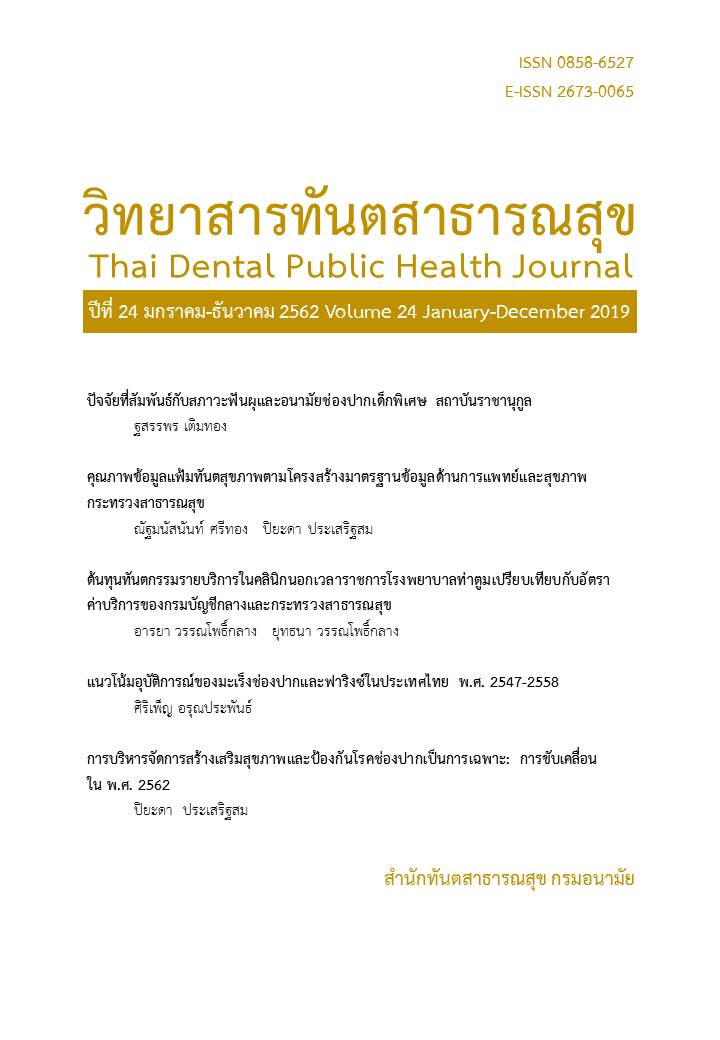Factors associated with dental caries and oral hygiene among special children at Rajanukul institute
Main Article Content
Abstract
The objective of the cross-sectional research was to study factors associated with dental caries and oral hygiene among 109 special children having neurodevelopmental disorder aged 3-18 years old who were receiving development trained at Rajanukul Institute during June-July, 2017. Two datasets were gathered. The care givers self-reported the oral behavioral questionnaire and a dentist examined children’s oral health status. The data was analyzed using percent, mean, standard deviation independent t test, and one way ANOVA. The significant value was set lower than 0.05. The overall caries prevalence was 59.6%. The mean decayed, missing and filled teeth of deciduous dentition (dmft) was 2.39 teeth per child and that of permanent dentition (DMFT) was 1.19 teeth per child. The oral hygiene was stated by the mean of debris, calculus and oral hygiene index were 1.00, 0.10 and 1.10 per child, respectively.
Many factors significantly affect mean DMFT were increasing age, male, tooth brushing compliance, and do tooth brushing by his/herself. While increasing age, brushing teeth by his/herself, drinking soft drink, candy or chocolate consumption, no dental visit last year, and visiting dentist irregularly were significantly factors affect the mean debris score. Only increasing age was the factor affect mean dmft and mean calculus score.
Downloads
Article Details
References
2. Petvijit T and Trairatvorakul C. Dental caries in early childhood in Trairatvorakul C, (eds) Dental prevention in child and adolescent. 4th Edition. Bangkok: Best book online printing; 2011 (in Thai) pp.43-122.
3. Sarumathi T, Saravana Kumar B, Datta M, Hemalatha VT, Nisha VA. Prevalence, severity and associated factors of dental caries in 3-6 year old children. J Clin Diagn Res 2013; 7(8):1789–92.
4. Altun C, Guven G, Akgun OM, Akkurt MD, Basak F, Akbulut E. Oral health status of disabled individuals attending special schools. Eur J Dent 2010; 4(4):361-66.
5. Jain M, Mathur A, Sawla L, Choudhary G, Kabra K, Duraiswamy P, Kulkami S. Oral health status of mentally disabled subjects in India. J Oral Sci 2009; 51(3):333-40.
6. Vinayak V, Annigeri R, Mittal S, Patel H. Adverse effects of drugs on saliva and salivary glands. J Orofac Sci 2013; 5(1):1-5.
7. Liu HY, Huang ST, Hsuao SY, Chen CC, Hu WC, Yen YY. Dental caries associated with dietary and toothbrushing habits of 6- to 12-year-old mentally retarded children in Taiwan. J Dent Sci 2009; 4(2):61-74.
8. Shapira J, Efrat J, Berkey D, Mann J. Dental health profile of a population with mental retardation in Israel. Spec Care Dent 1998; 18(4):149-55.
9. Gardens SJ, Krishna M, Vellappally S, Alzoman H, Halawany HS, Abraham NB. Oral health survey of 6-12-year-old children with disabilities attending special schools in Chennai, India. Int J Paediatr Dent 2014; 24(6):424-33.
10. Diab HA, Salameh Z, Hamadeh GN, Younes G, Ayoub F. Oral health status of Institutionalized Individuals with intellectual iisabilities in Lebanon. J Oral Maxillofac Res .2017; 8(1) e4:1-10.
11. Braúna AP, Abreu MH, Resende VL, Castilho LS. Risk factors for dental caries in children with developmental disabilities. Braz Oral Res 2016; 30(1).e79:1-7.
12. Moynihan P, Petersen PE. Diet, nutrition and the prevention of dental diseases. Public Health Nutr 2004; 7(1A):201-26.
13. Horowitz HS. The 2001 CDC recommendations for using fluoride to prevent and control dental caries in the United States. J public Health Dent 2003; 63(1): 3-8.
14. Australian Institute of Health and Welfare, University of Adelaide. Oral health and dental care in Australia: key facts and figures 2015. Canbera: Australian Institute of Health and Welfare; 2016.
15. Yosit U. Behaviors and factors associated with oral health care by parents of preschool children in child care, municipal Tha Pha District, Lampang Province. The degree of Master of Public Health.Thammasart University, Bangkok; 2016. (In Thai)
16. TuangRattanapan S, TuangRattanapan S, Chompoo-inwai P, Sirimaharat V. Brushing and dental caries prevention. Thai Dent Publ Health J 2006;11(1–2):41–9. (In Thai)
17. Torarid C. Factors related to oral health care behaviors of disabled, Buayai subdistrict, Buayai district, Nakorn Ratchasima province. Thai Dent Nurse J. 2015; 26(2):64–72.
18. World Health Organization.Oral health surveys: basic methods. England 4th ed: World Health Organization; 1997.
19. Greene JC. Oral hygiene and periodontal disease. Am J Public Health Nations Health 1963; 53:913–22.
20. Green JC, Vermillion JR. The Simplified oral hygiene index. J Am Dent Assoc 1964; 68:7-13.
21. Bureau of Dental Health. The 8th national oral health survey 2017 of Thailand, 2017. [cited 2019 July 6]; Available from: URL: https://dental2.anamai.moph.go.th/ewt_dl_link.php?nid=2423 (InThai)
22. Frencken JE, Sharma P, Stenhouse L, Green D, Laverty D, Dietrich T. Global epidemiology of dental caries and severe periodontitis-a comprehensive review. J ClinPeriodontol 2017; 44:S94–105.
23. Costa AA, Della Bona Á, Trentin MS. Influence of Different Intellectual Disability Levels on Caries and Periodontal Disease. Braz Dent J2016;27(1):52-5.
24. Huang ST, Hurng SJ, Liu HY, Chen CC, Hu WC, Tai YC, et al. The oral health status and treat-ment needs of institutionalized children with cerebral palsy in Taiwan. J Dent Sci 2010; 5(2):75–89.
25. Bureau of Information, Office of the Permanent Secretary of MOPH. Soft drink causes dental caries and obesity in children. [on line] 17 April 2015 [cited 2018 Apr 6]; Available from: URL: https://pr.moph.go.th/iprg/include/admin_hotnew/show_hotnew.php?idHot_new=72290 (in Thai)
26. Liu Z, Yu D, Luo W, Yang J, Lu J, Gao S. Impact of oral health behaviors on dental caries in children with intellectual disabilities in Guangzhou, China. Int J Environ Res Public Health 2014; 11(10):11015-27.
27. Center for Child and Human Development. Understanding the oral health needs of individuals with intellectual and developmental disabilities: The nurse’s roles. [online] 21 March 2013 [cited 2018 Apr16]; Available from: URL: https//ucedd.georgetown.edu/DDA/documents/Oral-Health/
28. American Academic of Pediatric Dentistry. Periodicity of examination, preventive dental services, anticipatory guidance/ counseling, and oral treatment for Infants, children, and adolescents. Reference Manual 2018; 40(6): 194-203.
29. American Academic of Pediatric Dentistry. Management of dental patients with special care needs. Reference Manual 2016; 40(6):237-242.
30. Dharmani CK. Management of children with special health care needs (SHCN) in dental office. J Med Soc 2018; 32:1-6.


